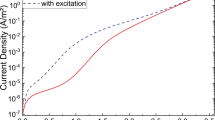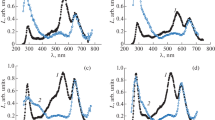Abstract
The nanostructures on silicon oxide, as a new phase of matter, only allows conducting electrons to exist on its surfaces, in which the edge electronic states dramatically provide intriguing insights into the world of low-dimensional quantum systems featuring and proposing the mechanisms of optical mode formation. We report that the formations of a nanolayer and a nanodisk structure on silicon oxide have been produced by using a novel preparation methodology, mainly involving the pulsed laser deposition in oxygen environment and the coherent electron beam irradiation process. Here, the structures of the Si nanolayer and the nanodisk on silicon oxide have been observed in the TEM images. The electronic edge states in the Si nanostructures on silicon oxide for emission were demonstrated in photoluminescence measurement. The simulation model of the Si nanostructures on silicon oxide has been built according the experimental results. And the results of the simulating calculation demonstrated that the Dirac relation is competition with the quantum confinement effect in the geometry change of the Si nanostructures on silicon oxide, in which the transforming edge states into direct bandgap can be realized for better emission.











Similar content being viewed by others
Data availability
The data that support the findings of this study are available from the corresponding author upon reasonable request.
References
M.Z. Hasan, C.L. Kane, Topological insulators. Rev. Mod. Phys. 82, 3045 (2010). https://doi.org/10.1103/Rev.Mod.Phys.82.3045
P. Li, X. Yang, Q.-S. Jiang, Y.-Z. Wu, W. Xun, Built-in electric field and strain tunable valley-related multiple topological phase transitions in VSiXN4 (X = C, Si, Ge, Sn, Pb) monolayers. Phys. Rev. Materials 7, 064002 (2023). https://doi.org/10.1103/Phys.Rev.Materials.064002
X. Zhang, Z.N. Farzad, Z.G. Chen, M.H. Lu, J. Christensen, A second wave of topological phenomena in photonics and acoustics. Nature 618, 687 (2023). https://doi.org/10.1038/s41586-023-06163-9
H.F. Wang, B.Y. Xie, P. Zhan, M.H. Lu, Y.F. Chen, Research progress of topological photonics. Acta Physica Sinica 68, 224206 (2019). https://doi.org/10.7498/aps.68.20191437
T. Ozawa, H.M. Price, A. Amo, N. Goldman, M. Hafezi, L. Lu, M.C. Rechtsman, D. Schuster, J. Simon, O. Zilberberg, I. Carusotto, Topological photonics. Rev. Mod. Phys. 91, 015006 (2019). https://doi.org/10.1103/RevModPhys.91.015006
G. Ma, M. Xiao, C.T. Chan, Topological phases in acoustic and mechanical systems. Nat. Rev. Phys. 1, 281 (2019). https://doi.org/10.1038/s42254-019-0030-x
M. Kim, Z. Jacob, J. Rho, Recent advances in 2d, 3d and higher-order topological photonics. Light Sci. Appl. 9, 130 (2020). https://doi.org/10.1038/s41377-020-0331-y
S. Mordechai, M.A. Bandres, Topological photonics: where do we go from here? Nanophotonics 10, 425 (2021). https://doi.org/10.1515/nanoph-2020-0441
A. Ghatak, M. Brandenbourger, J. van Wezel, C. Coulais, Observation of non-hermitian topology and its bulk-edge correspondence in an active mechanical metamaterial. Proc. Natl. Acad. Sci. 117, 29561 (2020). https://doi.org/10.1073/pnas.2010580117/-/DCSupplemental
F.D.M. Haldane, S. Raghu, Possible realization of directional optical waveguides in photonic crystals with broken time-reversal symmetry. Phys. Rev. Lett. 100, 013904 (2008). https://doi.org/10.1103/PhysRevLett.100.013904
M. Fujita, Nanocavity brightens silicon. Nat. Photon 7, 264–265 (2013). https://doi.org/10.1038/nphoton.2013.65
S. Botti, J.A. Flores-Livas, M. Amsler, S. Goedecker, M.A.L. Marques, Low-energy silicon allotropes with strong absorption in the visible for photovoltaic applications. Phys. Rev. B 86, 121204(R) (2012). https://doi.org/10.1103/PhysRevB.86.121204
D.Y. Kim, S. Stefanoski, O.O. Kurakevych, T.A. Strobel, Nat. Mater. 14, 169–173 (2015). https://doi.org/10.1038/nmat4140
M. Hafezi, E.A. Demler, M.D. Lukin, J.M. Taylor, Robust optical delay lines with topological protection. Nat. Phys. 7, 907–912 (2011). https://doi.org/10.1038/nphys2063
T. Aubert, K. Ma, K.W. Tan, U. Wiesner, Two-dimensional superstructures of silica cages. Adv. Mater. (2020). https://doi.org/10.1002/adma.201908362
Z. Wang, Y. Chong, J.D. Joannopoulos, M. Soljačić, Observation of unidirectional backscattering-immune topological electromagnetic states. Nature 461, 772–775 (2009). https://doi.org/10.1038/nature08293
M. Hafezi, S. Mittal, J. Fan, A. Migdall, J.M. Taylor, Nature Photon 7, 1001–1005 (2013). https://doi.org/10.1038/nphoton.2013.274
L. Pilozzi, C. Conti, Topological lasing in resonant photonic structures. Phys. Rev. B 93, 195317 (2016). https://doi.org/10.1103/PhysRevB.93.195317
B. Bahari, A. Ndao, F. Vallini, A. El Amili, Y. Fainman, B. Kante, Nonreciprocal lasing in topological cavities of arbitrary geometries. Science 358, 636–640 (2017)
M.A. Bandres, S. Wittek, G. Harari, M. Parto, J. Ren, M. Segev, D.N. Christodoulides, M. Khajavikhan, Topological insulator laser: experiments. Science 359, 4005 (2018). https://doi.org/10.1126/science.aar4005
M. Liu, X.B. Yin, E. Ulin-Avila, B.S. Geng, T. Zentgraf, L. Ju, F. Wang, X. Zhang, A graphene-based broadband optical modulator. Nature 474, 64–67 (2011). https://doi.org/10.1038/nature10067
H. Yu, H. Zhang, Y. Wang, C. Zhao, B. Wang, S. Wen, H. Zhang, J. Wang, Topological insulator as an optical modulator for pulsed solid-state lasers. Laser Photon. Rev. 7, L77–L83 (2013). https://doi.org/10.1002/lpor.201370062
G.Q. Liang, Y.D. Chong, Optical resonator analog of a two-dimensional topological insulator. Phys. Rev. Lett. 110, 203904 (2013). https://doi.org/10.1103/PhysRevLett.110.203904
W.L. Ng, M.A. Lourenco, R.M. Gwilliam, S. Ledain, G. Shao, K.P. Homewood, An efficient room-temperature silicon-based light-emitting diode. Nature 410, 192–194 (2001). https://doi.org/10.1038/35065571
T.N. Theis, P.M. Solomon, It’s time to reinvent the transistor. Science 327, 1600–1601 (2010). https://doi.org/10.1126/science.1187597
Acknowledgements
This work was supported by the National Natural Science Foundation of China (Grant No.11847084, 62264002) and supported by the Guizhou Province (ZK[2022]010).
Author information
Authors and Affiliations
Corresponding author
Ethics declarations
Conflict of interest
The authors have no financial or proprietary interests in any material discussed in this article.
Additional information
Publisher's Note
Springer Nature remains neutral with regard to jurisdictional claims in published maps and institutional affiliations.
Rights and permissions
Springer Nature or its licensor (e.g. a society or other partner) holds exclusive rights to this article under a publishing agreement with the author(s) or other rightsholder(s); author self-archiving of the accepted manuscript version of this article is solely governed by the terms of such publishing agreement and applicable law.
About this article
Cite this article
Huang, ZM., Zhang, X., Li, Yl. et al. Edge Electronic States and Direct Bandgap in Si Nanostructures on Silicon Oxide. Trans. Electr. Electron. Mater. (2024). https://doi.org/10.1007/s42341-024-00516-5
Received:
Revised:
Accepted:
Published:
DOI: https://doi.org/10.1007/s42341-024-00516-5




